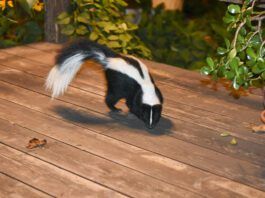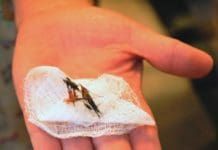Letters and Corrections: September 2018
The mask" is the Outfox Field Guard
Symptoms and Treatment of Foxtail Invasions in Dogs
While some ?rst aid may be possible in the event of a foxtail wound, in almost all cases you should get your dog to a veterinarian as soon as possible. Delaying treatment allows the foxtail to do further damage; avoiding foxtail treatment altogether could lead to your dog developing a chronic illness or could even lead to death.
Foxtail Grass: Awns of Destruction for Western Dogs
The seeds of the nasty foxtail grass seem to have a special affinity for invading dogs' bodies. The three most common hazards of foxtails to dogs are these: They get sniffed into dog noses, work their way into dog ears, and lodge between dog toes. Each of these sites is a mere port of entry for these sturdy seeds; once inside, they start a relentless crawl forward, traveling deeper into a dog's tissue with every passing hour. They are sometimes found in exploratory surgeries years afterward; the durable seed and awn fibers resist breaking down in the body as if they were made of plastic.
Suggested Dog Park Rules
The most successful dog parks have rules and people who enforce them. Registration and numbered armbands make it easier to identify rule-breakers, which helps with enforcement. Here are some suggested rules for dog parks, which you should feel free to share with your community.
Earth-Friendly Dog Poop Disposal
Lots of us go out of our way to look for biodegradable dog waste bags. After all, we want to be earth-friendly in as many ways as possible. Who wants to think of their dog's poop festering away in a traditional polymer bag designed to survive a zombie apocalypse? Unfortunately, the term biodegradable" isn't all it's cracked up to be. Truth is
Advocate for Your Dog
Willow. She scans for hazards (snakes
Keep Your Dog Safe from Water Hazards
We've had some intense heat in California lately, and lots of dog owners are taking their dogs to pools, lakes, rivers, and the coast to cool off. Allow me to remind you about several water-safety tips to keep in mind: Too much can be a bad thing. "Water toxicosis" can affect any dog who drinks too much in the course of swimming, dock diving, fetching toys from water, biting at a sprinkler, or any other activity that involves water. When dogs are hot or particularly excited, they may drink even more. If you notice your dog drinking more than seems necessary - especially if you notice him wobbling, vomiting, or seeming suddenly lethargic, have him take a break in the shade for a while, until his body can catch up and eliminate some of that excess. See https://www.whole-dog-journal.com/care/water-intoxication-in-dogs/
Why is Blue-Green Algae Dangerous to Dogs?
Water is wonderful, but not if it's toxic. When conditions promote the growth or bloom" of toxic blue-green algae in lakes and ponds
Symptoms of Heat Stress
A dog exhibiting any of these symptoms needs immediate veterinary care as brain damage, kidney failure, seizures, and death can occur:
Short-Nosed Dogs
The brachycephalic breeds such as Pugs, Boston Terriers, Boxers, Bulldogs are particularly at risk of heat stress, says Eileen Fatcheric, DVM, of Syracuse, New York. The only way dogs have to thermoregulate their bodies is panting
How to Keep Your Dog Cool in Hot Weather
Dogs find summer's high temperatures challenging. That's largely because they don't sweat. Sure, you've read that dogs have sweat glands in their paws, but veterinarians agree that's not much help. A dog's primary means of cooling himself is through panting and our goal is to make this process more efficient.
Letters and Corrections: June 2015
In the May issue, we published an article, Outfoxing Foxtails
















